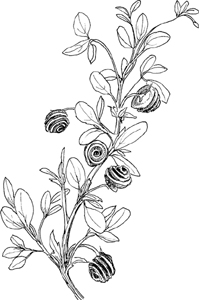
BOTANICAL NAME: Medicago scutellata
FAMILY: Leguminosae

I love snails. Not the fat escargots that have invaded my garden and fallen upon my spring vegetables like a hoard of locusts but rather the charming little green snails that are conspicuous by their ability to hide even when planted right beside a border or path. This is an annual, creeping plant that is closely related to alfalfa (Medicago sativa) but which is not given much space in garden literature now that it has fallen out of fashion as a medicinal plant. It was first grown in England in the late 1500s, and we know that as early as 1754 William Logan of Pennsylvania was growing snails in this country, although it is not clear what use he intended for them.
Under the old medical system of virtues and sympathies, snails were deemed cold and therefore useful as poultices for cooling inflammations. Writing in 1597, the English botanist John Gerard called them Medicke Fodder and Snail Claver, and pointed out that the seeds tasted like peas when cooked. It would, however, take a great many seeds to make a meal, for while they resemble lima beans in shape they are barely one-third the size of a cucumber seed.
Snails are a wild plant native to southern Europe. They are called limaçons in France and caracols in Spain, and many people grow them for the amusement of their children. I suppose I am a child at heart. When I first saw snails growing around the base of an ancient marble Roman bathtub ornamenting a country garden near Verona many years ago, the urge came upon me that this I must have. The culinary possibilities were obvious.
If the pods are picked while they are green and tender, they can be steamed or poached and employed as garnishes. They can be scattered over salads or even tossed in with brined vegetables to give the mixture added visual appeal. I have even tried pickling them like capers and then using them in sauces for fish. No matter how they are prepared, green snails will elicit comments from dinner guests and launch table conversation in the direction of gustatory discourse. It always works.